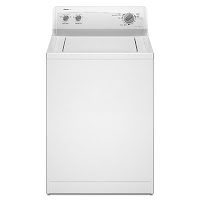You want to think of the smooth top on your stove like the paint on your car. You must clean and protect it from dirt, grease and grime. Regular cleaning is an absolute must when you own one of these. There is no way around it. But, if you want it to look like garbage, then stop reading now. If you are interested in keeping your cooktop looking like its brand new, read on my friend.
There are a couple of supplies that you are going to need to begin. Number one being being cooktop cleaner. Whether it's generic or Cerama Bryte or whatever, you will need this. Do not use anything else other than cooktop cleaner. Stop using Windex, bleach water, soapy water or whatever home concoction you have been using. By using these products you are making cleaning your glass top much harder than what it really needs to be. Seriously.
The next most important cleaning supply you are going to need is a green scotch brite pad. These are very cheap and readily available pretty much anywhere. There is no reason to not have a box or two of these around. These are very effective for cleaning off burnt grease and and water stain marks. Don't even think about using your washcloth. It does not have the scrubbing power. The glass top on your stove will be just fine. You will not hurt it at all.
Number three is going to be a razor blade scraper. You will need this if you have not kept up with your cooktop cleaning duties. I can tell you right now that you will not be able to properly clean your stove without one of these. So make sure you have one when you are ready to begin. You would be surprised of how many people don't realize or are afraid to use a razor blade on their stove. Now you know that it is OK, let's move on to the last thing you will need.
The last supply that you are going to want to have are some paper towels. You will need precisely two full sheets. Do not use the paper towels that feel like cloth. They may work for other cleaning purposes, but not for this. Just trust me on this, they suck for this job. Cheap paper towels work the best. This is based off me cleaning hundreds of stove tops for people as a courtesy.
Now that you know what you need, let me tell you how to accomplish this mission. Make sure that you are not cleaning your stove when the top is still hot from cooking. Let it cool before you begin.
Step one is going to be applying the cooktop cleaner. You want to use a generous amount to make sure that you can rub on a thick coat of this stuff. Step two is going to be to use your green scotch brite pad to rub and scrub as much grease and grim off the cooktop as you can. While the cleaner is spread around this is where you want to razor blade the areas that will not scrub off. Once you have gotten off all the grease and grim that you can, its time to buff it clean. Use a paper towel or clean rag to wipe off most of the excess cleaner. You want to leave a thin coat still on the top. This thin coat will haze over. After it hazes over, go ahead and use a clean part of your rag or a new paper towel to finish buffing the top to a shine.
This method will work every time. This should be the only way that you clean the top of your stove. I am without a doubt sure that if you clean it like this regularly, your top will look brand new the entire time you own your glasstop stove.
Make sure you watch the video on this page. This is me giving a demonstration on what this article is about. Give the video a thumbs up on YouTube. Leave some comments if you have any questions or just want to say something. I do my best to respond to every comment left on my YouTube channel. Thanks for taking the time to read and watch this. Good Luck with your new cooktop or your dirty cooktop that is going to look its best in years.
To read more on Caring for you Stove follow this link.
